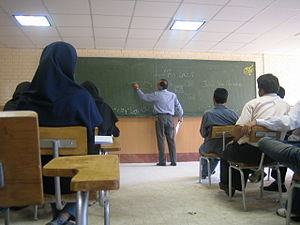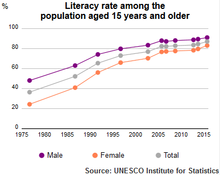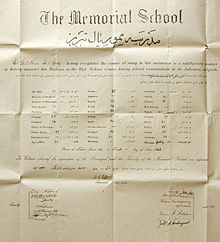ഇറാനിലെ വിദ്യാഭ്യാസം

ഇറാനിലെ വിദ്യാഭ്യാസം കേന്ദ്രീകൃതമാണ്. ക്-10 വിദ്യാഭ്യാസവും ഉയർന്ന വിദ്യാഭ്യാസം ചേർന്നതാണത്. കെ 10 വിദ്യാഭ്യാസം ഇറാനിലെ വിദ്യാഭ്യാസ മന്ത്രാലയത്തിന്റെ നിയന്ത്രണത്തിലും ഉന്നതവിദ്യാഭ്യാസം അവിടത്തെ ശാസ്ത്ര സാങ്കേതിക മന്ത്രാലയത്തിന്റെയും ആരൊഗ്യ വൈദ്റ്റവിദ്യാഭ്യാസ മന്ത്രാലയത്തിന്റയും കീഴിലാണ്. സെപ്തംബർ 2015ലെ കണക്കു പ്രകാരം ഇറാനിലെ 95% മുതിർന്നവരും സാക്ഷരർ ആണ്.[1] 2008ൽ ഇറാനിലെ സാക്ഷരതാനിരക്ക് 85% ആയിരുന്നു. ഇറാനുൾപ്പെട്ട പ്രദേശത്തെ സാക്ഷരതാ നിരക്ക് ശരാശരി 62% മാത്രമായിരിക്കുമ്പോൾ ആണ് ആ പ്രദേശത്തെഏറ്റവും ഉയർന്ന സാക്ഷരതാനിരക്കാണിത്.15നും 24നും ഇടയിലുള്ള ഇറാങ്കാരുടെ സാക്ഷരതാനിരക്ക് 97% ആണെന്നു കണക്കുകൾ പറയുന്നു. സ്ത്രീപുരുഷന്മാരിൽ ഇക്കാര്യത്തിൽ യാതൊരു വ്യത്യാസവുമില്ല. 2007 ആയപ്പോഴെയ്ക്കും ഇറാനിൽ വിദ്യാർത്ഥികളും തൊഴിലാളികളും തമ്മിൽ 10.2% ആണ് അനുപാതം. ഇത് ലോകത്തിൽത്തന്നെ ഏറ്റവും വലിഅയ അനുപാതമാണിത്.[2]
Primary school (Dabestân دبستان) എന്ന പ്രാഥമികവിദ്യാലയങ്ങളിൽ ആറു വയസിൽ കുട്ടിയെ ചേർക്കുകയും ആറു വർഷം അവിടെ പഠിക്കുകയും ചെയ്യുന്നു. തുടർന്ന് മിഡിൽ സ്കൂളിൽ Dabirestân (Dabirestân دروه اول دبیرستان), ആണ് കുട്ടി ചേരേണ്ടത്. ഇത് 3 വർഷമാണ്. പിന്നീട് (Dabirestân دوره دوم دبیرستان),എന്നറിയപ്പെടുന്ന ഹൈസ്കൂൾ ആണ് ഇത് നിർബന്ധിതമല്ല. 3 വർഷമാണിതിന്റെ പരിധി, ഇതിൽ ടെക്നിക്കൽ കോഴ്സിനോ മറ്റു വിഷയങ്ങളിലോ ചേരാവുന്നതാണ്.ഓരൊ വിഷയത്തിനും അതിന്റേതായ പ്രത്യെകതയുണ്ടാവും.[3] Iranian University Entrance Exam (Konkur کنکور),നു ശേഷമാണ് ഉന്നതവിദ്യാഭ്യാസത്തിനു അർഹത നേടുന്നത്.
ഇറാന്റെ വിദ്യാഭ്യാസത്തിന്റെ ചരിത്രം[തിരുത്തുക]
Modern education[തിരുത്തുക]

പാഠ്യപദ്ധതി[തിരുത്തുക]
| Age | Level of education (പേർഷ്യൻ) | Duration | US degree equivalent | Remarks |
|---|---|---|---|---|
| 5-6 | Pre-primary/Kindergarten | 1 year (K-12) | Optional. 50% of children at that age are enrolled in pre-primary education. | |
| 6-12 | Elementary education/Dabestan | 6 years (K-12) | Although elementary education is free and compulsory, full enrollment in elementary education has not yet been achieved (2004). | |
| 12-16 | Lower-secondary/ First 3 Years of Dabirestan | 3 years (K-12) | Middle school | Mandatory (6-9th grade). (Free) The aim of this level of education is to figure out the capabilities and skills of a child so that the education system could guide her or him to the most appropriate track after the end of compulsory education. |
| 15-18 (or older) | Upper-secondary/Second 3 Years Dabirestan | 3 years (K-12) | High school diploma (Diplom-Motevaseth) | In Iran, upper-secondary education is NOT compulsory. By 2010, 80% of children aged between 14 and 17 were enrolled. Approximately 6% of upper secondary institutions are private. These schools must conform to the regulations of the Ministry of Education, though they are financed primarily through tuition fees received from students. There are three school types: the theoretical branch, the technical-vocational/professional branch, and the manual skills branch (Kar-Danesh). The latter two prepare students to directly enter the job market in the trading, agricultural, industrial professions. The Kar-Danesh track develops semi-skilled and skilled workers, foremen, and supervisors. Besides, each path has its own specialties (e.g. 'math/physics'; 'experimental sciences' or 'literature/humanities' in the case of the theoretical path). Students with High school Diploma Certificate earn the right to take the Konkur, i.e. the competitive National Entrance Examination. In 2009: ~11% were admitted (1,278,433 entrants), 60% of which were female[4] Students passing the Konkur obtain the degree equivalent of a GCE A-levels and/or International Baccalaureate. |
| 18-20 (or older) | Technical/Vocational School OR (see below) | 2 years | Associate Degree (Fogh-e-Diplom or Kārdāni) | Students are able to study two more years in tertiary education, which provides them with the skills to become a highly skilled technician and receive an “integrated associate degree” |
| 18-22 (or older) | University (undergraduate) | 4 years | Bachelor degree (Kārshenāsi or Licence) | Academic year: September through June. Students attend classes Saturday through Thursday. Academic term divided in 2 'semesters' and 'course credits'. Universities receive their budget money from the state, and students normally do not pay for tuition and boarding at these institutions (except for Islamic Azad University). |
| 22-24 (or older) | University (graduate) | 2 years | Master degree (Kārshenāsi-ye Arshad or Fogh Licence) | Iran hosts some of the most prestigious universities in the Middle East such as Tehran University of Medical Sciences, Tehran University, Sharif University, and Iran University of Science and Technology (all three rank among the top 1,000 universities of the world according to SCImago international rankings). Shiraz University, Isfahan University of Technology, Shahid Beheshti University of Tehran, Ferdowsi University of Mashhad, and Amirkabir University of Technology (Tehran) are other prominent higher education institutes in the country. See also: List of Universities in Iran |
| 24-27/8 (or older) | Doctoral program | 3-4 years | PhD. (Karshenasi-arshad-napayvasteh or Doctora) | Students are admitted following an entrance exam. See also: Higher education in Iran. In 2012, Iran had 120,000 PhD students.[5] In 2013, only ~60,000 PhD students according to the United Nations Conference on Trade and Development.[6] |
| ORIENTATION CYCLE PROGRAM | Weekly hours | ||
| 6th grade | 7th grade | 8th grade | |
| Persian Language and Literature | 5 | 5 | 5 |
| Maths | 5 | 5 | 5 |
| Natural Sciences | 4 | 4 | 4 |
| Religious Education | 2 | 2 | 2 |
| History | 1 | 1 | 1 |
| Geography | 1 | 1 | 1 |
| Arabic | 2 | 2 | 2 |
| Social sciences | 1 | 1 | 1 |
| Arts | 2 | 1 | 1 |
| Technical/Vocational Education | 3 | 3 | 3 |
| Foreign language | - | 4 | 4 |
| Military service preparation (for boys only) | - | - | 1 |
| The Quran | 2 | 2 | 2 |
| Total: | 28 | 31 | 32 |
| Source : World Education Services, 2004 | |||
ബഡ്ജറ്റ്[തിരുത്തുക]
വിദ്യാഭ്യാസത്തിനായി സർക്കാർ 20% ആണു ചെലവാക്കുന്നത്. ജി ഡി പിയുടെ 5% ആണ്.[7]
വിദ്യാഭ്യാസ പരിഷ്കരണം[തിരുത്തുക]
അദ്ധ്യാപക വിദ്യാഭ്യാസം[തിരുത്തുക]
വിദേശഭാഷകൾ[തിരുത്തുക]
ഇന്റർനെറ്റും വിദൂരവിദ്യാഭ്യാസവും[തിരുത്തുക]
ഉന്നതവിദ്യാഭ്യാസം[തിരുത്തുക]
| Field of study | 2010 | Remarks |
|---|---|---|
| Engineering and construction | 31% | One of the highest rates in the world. |
| Social science, business and law | 23% | Poorly developed (partly because of ideology issues).[9] |
| Humanities and the arts | 14% | |
| Science | 10% | Poorly supported. |
സംരംഭകത്വം[തിരുത്തുക]
സ്ത്രീവിദ്യാഭ്യാസം[തിരുത്തുക]
പ്രത്യേക കഴിവുള്ള കുട്ടികൾക്കുള്ള വിദ്യാഭ്യാസം[തിരുത്തുക]
വിദ്യാഭ്യാസ ഗവേഷണത്തിനും പ്ലാനിങ്ങിനുമുള്ള സംഘടന (OERP)[തിരുത്തുക]
ഇറാനിലെ അരിയപ്പെറ്റുന്ന ഹൈസ്കൂളുകൾ: ചരിത്രത്തിലേയും ഇന്നത്തെയും[തിരുത്തുക]

വിവിധ കണക്കുകൾ[തിരുത്തുക]
ഇതും കാണൂ[തിരുത്തുക]
- International Rankings of Iran in Education
- Science and technology in Iran
- List of Iranian Research Centers
- Darolfonoon
- Modern Iranian scientists, scholars, and engineers
- Economy of Iran
- Hassan Roshdieh
- Iranian people
- Nodet
- Media in Iran
- Sport in Iran
- Social class in Iran
കുറിപ്പുകൾ[തിരുത്തുക]
- ↑ http://www.farsnews.ir/newstext.php?nn=13940629000008
- ↑ "Archived copy" (PDF). Archived from the original (PDF) on 2011-01-12. Retrieved 2012-04-11.
{{cite web}}: CS1 maint: archived copy as title (link) - ↑ "WEP-Iran". Wes.org. Archived from the original on 2012-02-24. Retrieved 2012-02-07.
- ↑ "Education in Iran - Part I". Retrieved 2010-01-10.
{{cite web}}:|first=missing|last=(help); Check|first=value (help)|first1=missing|last1=in Authors list (help) - ↑ "ആർക്കൈവ് പകർപ്പ്". Archived from the original on 2017-06-30. Retrieved 2017-09-29.
- ↑ "Science, Technology and Innovation Policy Review – The Islamic Republic of Iran" (PDF). United Nations Conference on Trade and Development. 2016. Archived from the original (PDF) on 2016-12-20. Retrieved 7 December 2016.
{{cite journal}}: Cite journal requires|journal=(help)CS1 maint: postscript (link) - ↑ Nash, Jason John; Sasmaz, Aytng (January 2011). "The Business Year 2011: Iran". London, U.K.: The Business Year: 232. ISBN 978-1-908180-00-1.
{{cite journal}}: Cite has empty unknown parameter:|chapterurl=(help); Cite journal requires|journal=(help)CS1 maint: postscript (link)[പ്രവർത്തിക്കാത്ത കണ്ണി] - ↑ http://www.thebusinessyear.com/tby_demo/[പ്രവർത്തിക്കാത്ത കണ്ണി]/publications.php?art_id=113&type=sector§or=healtheducation
- ↑ http://www.al-monitor.com/pulse/originals/2014/02/iran-universities-inferior-doctoral-degrees-shoddy-research.html#ixzz4TAHLs2hb
